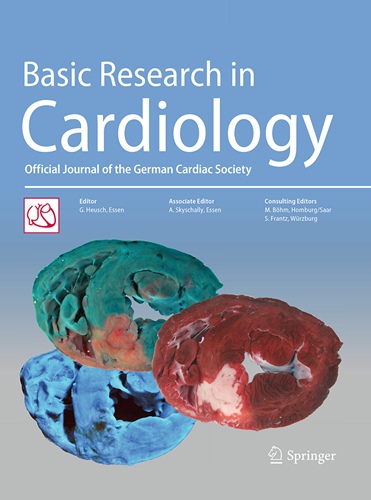声源性神经调节通过脑-心回路预防心肌梗死后恶性心律失常和心脏重构。
IF 8
1区 医学
Q1 CARDIAC & CARDIOVASCULAR SYSTEMS
引用次数: 0
摘要
室旁核(PVN)交感神经过度激活加剧心肌梗死后(MI)恶性室性心律失常(VAs)和心脏重构。声遗传学是一种新兴的可逆性神经调节技术,可以实现对目标神经元的精确时空控制。然而,目前的声发生神经调节(SGN)策略主要是为了促进神经元的激活而设计的,支持神经元抑制的实验证据仍然缺乏。在本研究中,我们首次通过机械敏感离子通道——twik相关花生四烯酸激活K+通道(TRAAK)进行了抑制性声发生神经调节系统。将rAAV2/9-hsyn-TRAAK-P2A-EGFP微注射到PVN中,使TRAAK过表达。采用经颅超声刺激(TUS) (1.0 MHz, 2.0 W/cm2)激活TRAAK通道,促进交感超极化。通过心电图记录、心脏电生理实验和组织病理学染色来评估声源性神经调节在心肌梗死急性期和慢性期的保护作用。结果表明声源性神经调节可以逆转心肌梗死引起的过度交感神经激活和自主神经失衡。声源性神经调节可预防急性mi诱导的恶性VAs,并通过pvn -左星状神经节(LSG)-心脏回路改善心肌炎症微环境。在心肌梗死的慢性期,长期的声源性神经调节已被证明可以减轻心功能障碍,抑制心室重构,改善心脏电生理稳定性。总的来说,traak介导的PVN声源调节抑制交感神经过度激活,从而防止心肌梗死引起的恶性心律失常和不良的心脏重构。本文章由计算机程序翻译,如有差异,请以英文原文为准。
Sonogenetic neuromodulation prevents post-myocardial infarction malignant arrhythmia and cardiac remodeling through the brain-heart circuit.
Sympathetic hyperactivation within the paraventricular nucleus (PVN) exacerbates post-myocardial infarction (MI) malignant ventricular arrhythmias (VAs) and cardiac remodeling. Sonogenetics is an emerging reversible neuromodulation, which might achieve precise spatio-temporal controllability over targeted neurons. However, the current sonogenetic neuromodulation (SGN) strategies are mainly designed to facilitate neuronal activation, and experimental evidence supporting neuronal inhibition remains elusive. In the current study, we conducted the first inhibitory sonogenetic neuromodulation system by the mechanosensitive ion channel named TWIK-related arachidonic acid-activated K+ channel (TRAAK). rAAV2/9-hsyn-TRAAK-P2A-EGFP was microinjected into the PVN to overexpression TRAAK. Transcranial ultrasound stimulation (TUS) (1.0 MHz, 2.0 W/cm2) was employed to activate the TRAAK channels to facilitate sympathetic hyperpolarization. Electrocardiogram recordings, cardiac electrophysiological experiments, and histopathological staining were performed to assess the protective role of sonogenetic neuromodulation in the acute and chronic phases of MI. The results indicated that sonogenetic neuromodulation reverses the excessive sympathetic activation and autonomic imbalance induced by MI. Furthermore, sonogenetic neuromodulation prevents acute MI-induced malignant VAs and improves the myocardial inflammatory microenvironment through the PVN-left stellate ganglion (LSG)-heart circuit. In the chronic phase of MI, long-term sonogenetic neuromodulation has been demonstrated to alleviate cardiac dysfunction, inhibit ventricular remodeling, and improve cardiac electrophysiological stability. Collectively, TRAAK-mediated sonogenetic modulation of the PVN inhibits sympathetic hyperactivation, thereby preventing MI-induced malignant arrhythmias and adverse cardiac remodeling.
求助全文
通过发布文献求助,成功后即可免费获取论文全文。
去求助
来源期刊

Basic Research in Cardiology
医学-心血管系统
CiteScore
16.30
自引率
5.30%
发文量
54
审稿时长
6-12 weeks
期刊介绍:
Basic Research in Cardiology is an international journal for cardiovascular research. It provides a forum for original and review articles related to experimental cardiology that meet its stringent scientific standards.
Basic Research in Cardiology regularly receives articles from the fields of
- Molecular and Cellular Biology
- Biochemistry
- Biophysics
- Pharmacology
- Physiology and Pathology
- Clinical Cardiology
 求助内容:
求助内容: 应助结果提醒方式:
应助结果提醒方式:


